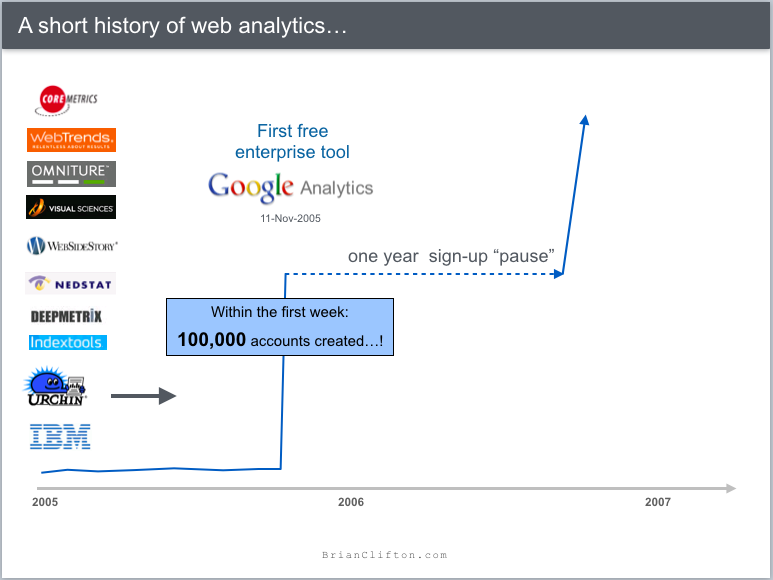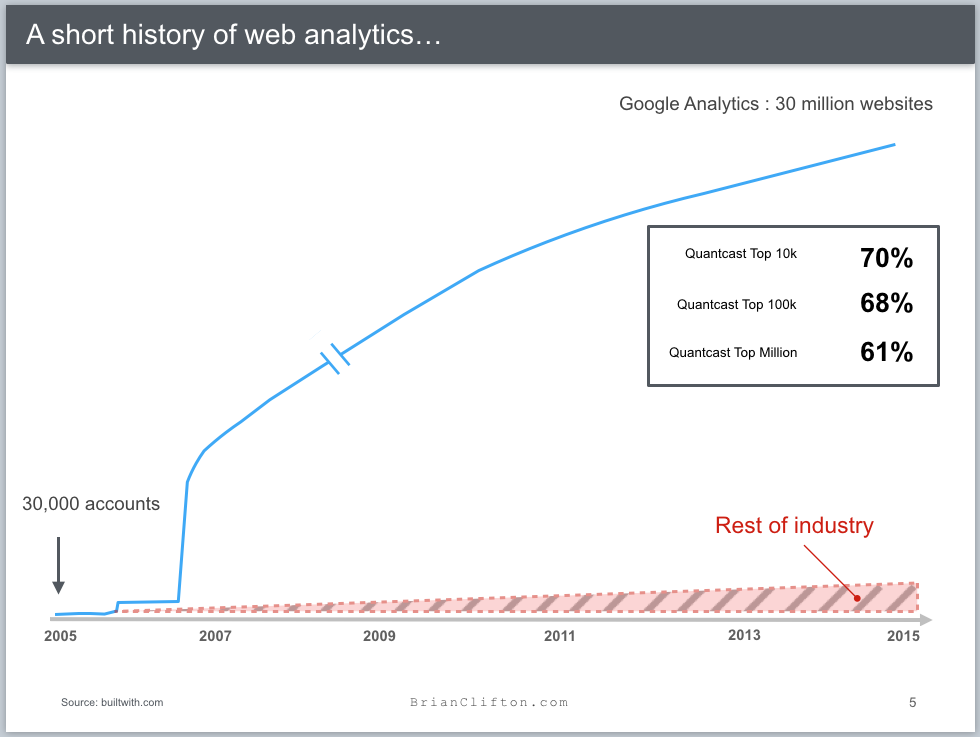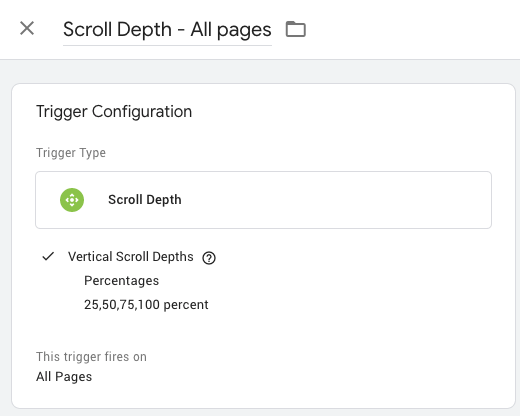Google Analytics launched on the 11th November 2005 (it was a Friday) – the result of acquiring a company called Urchin Software. It was a momentous day for two reasons:
- Google had entered the analytics space with a bang – releasing the first enterprise analytics product for FREE (unheard of then!).
- I was 5 weeks into my new job as Head of Web Analytics for Google Europe.
Clearly with such disruption, not everyone was happy. Free put a lot of pressure on competitors. Advertisers suspected Google had ulterior motives for collecting website data en masse. And Google itself struggled to keep up with demand. Within one week of launch 100,000 new accounts were created. That was 4x bigger than size of the entire industry at that time (see Figure 1)! The result was that we had to close off new sign-ups while literally thousands of new processors where procured in order to take on the new data processing…
Interesting times indeed and I made sure I absorbed as much media training as possible!
What has changed in 10 years?
Google Analytics is now present on 30 million websites – a 1000 fold increase(!) and it has become the standard for digital analytics collection and reporting, see Figure 2. Though the rest of the industry has grown in terms of account numbers, the main vendors existing now can be counted on less than one hand. That is a great shame – there has always been (and still is) opportunities for competitors to specialise in a way that Google cannot. However, competitor’s lack on understanding about Google’s direction with data contributed to their downfall. Often their reaction was to bad mouth GA and cast aspersions, rather than focusing on their own users and customers needs. As I said, my media training was essential then…
Figure 2. GA adoption has grown 1000x since launch
Features, Features and more Features…
There was a time (around 2009-12) when new features where being release almost monthly. Some were minor, though useful. Others had a much greater impact – both for the analyst, and on the industry. In Figure 3, I list what I consider to have been the most ground breaking features of Google Analytics over the past 10 years…
Figure 3. The Google Analytics major feature announcements
But so what…? Are you using any of these features?
A survey I am currently running (please also complete) is revealing – see Figure 4. It shows just how much opportunity there is to maximise your use of Google Analytics. Why do I say that? Because these 13 features are what I consider essential to use if you are really going to understand and their optimise your efforts for your visitors, prospects and customers.
Figure 4. Feature usage. Green bars represent %usage; Red bars represent %not used.
**Sample size is king when conducting surveys. Please help make this data as accurate as possible by completing the survey yourself (all anonymous)**
Observations so far – lots of red (not used)…
- Only 5.4% of respondents are using Content Experiments (A/B testing). Does this reflect on the difficulty of setting up Content Experiments – an issue I have commented on before?
- Two thirds of respondents are NOT using Multi-Channel Funnel reports (77% are not using Attribution Modelling) – despite this being repeatedly listed by digital marketers over the years as being a “must-have” feature i.e. wanting to understand conversions beyond the last click.
- 41% of respondents are NOT using Segmentation – that to me signals that 41% of users are not performing analysis, just reporting overall basic numbers.
- Custom Reports usage is unusually high at 68% – I wonder if this represents a confusion as to what segmentation is for (see point 3).
Food for thought… I will be returning to this story as the number of survey responses grows (currently at approx. 200). Subscribe to this post for updates…







Is there any way I could get a hold of the data you used for the graph showing the growth of Google Analytics? I’m working on a report about it and need to create my own visual representation. Unfortunately, I haven’t been able to find hard numbers despite searching extensively. I’d really appreciate being able to get a hold of it soon.
Hello Tyler – those are schematic charts. The real data is Google confidential…
Speaking out of the box, GA provides to the users a myriad of features like metrics and dimensions, targeting, reporting and so on. In my point of view, GA gave a new era in online world like his father does(Google). I hope they ‘ll try to add more features and become more competitive to some paid tracking tools(very few of them can compete GA).
Great post, very informative summary and also food for thoughts. Thanks!
Hey Brian, old friend!
Many thanks for this summary and resumé. I really enjoyed reading it since – like you – I’ve experienced these times since Urchin on Demand was released back in 2004.
Great times in the past and a bright future ahead. Google will keep up the good work and you will hopefully too.
Cheers,
Holger
10 years… that was fast! GA is a great tool and it has been providing a great service to millions of organizations around the world. I do think it needs a major revamp because it is still working within the paradigms of the last decade. Here’s why:
Ownership of data
You do not have access to clickstream data unless you pay 150k a year, still you can’t have IP addresses or keep any type of PII on GA.
Analysis Limitations
Because you don’t have access to your raw data, you are limited to the types of analysis GA provides. This doesn’t serve the business but rather drives demand for GA support services for whatever shinny ball is out that quarter. Exporting the data through the API is your best option, 7 dimensions and 10 metrics at a time, if you don’t have too much traffic … or pay $150k a year.
It’s an analysts tool
The interface has grown so much it has become unusable by most business users. Effectively, the ability to draw insights is hindered because you can’t slice / drill down as easy as today’s new data visualization tools (Tableau, Looker, Domo, Roambi, etc). The lack of a proper visualization layer hinders insights and action. GA needs a visualization layer.
No Re-Write
Bad data is a huge problem. Let’s say your client tagged campaigns inconsistently, you want to reprocess the data to fix it and do attribution on their marketing efforts. Not possible, even if you are Premium. You want to reconfigure a goal with a pageview that was being tracked … only works into the future.
I hope GA is able to re-invent itself in the next few years. On clients that are looking to create a data-driven culture, I wouldn’t recommend GA, there are better options for $150k/year.
Let’s see what GA will do in the next few years, with cloud computing and all the pixel data being collected these days everyone has the potential to become a web analytics provider.
Joao Correia
Joao – interesting criticism, but are you comparing apples with oranges? Here’s my 2 cents to your four points:
1. Ownership of data
Collecting IP addresses and personal info is a legal issue that is very much part of a global debate on privacy. For example, in the EU it is illegal for anyone to do this without the “explicit consent” of the visitor. Even then, there is the issue of where data is stored and under who’s jurisdiction i.e. Safe Harbour.
Google’e approach has always been to avoid such a quagmire – both for its business and for impacting end users i.e. the public. That has stood them well. Vendors and business who have collected personal info on users and shipped it off to the U.S. for storage and processing are now scrambling around trying to figure out how to unpick the mess they have created… I don’t see Google’s approach changing wrt privacy (I certainly hope not).
Some useful links:
-Safe Harbour: bbc.com/news/technology-34461682
-Privacy and the EU: brianclifton.com/?s=privacy+eu
2. Analysis Limitations
GA is a reporting tool. If a business wants to take responsible for raw data then they need to log it and take responsibility for it themselves i.e. not use GA. That was what organisations were considering 10-15 years ago, but few bothered. Why? The clear message then was that businesses did not want the hassle, responsibility (see point 1), and cost. It was/is way too expensive to buy a data warehouse or even use a virtual data warehouse – of the or millions of dollars per year. This was a key consideration of Google’s reasoning for entering the analytics market in 2005. I really don’t see this changing…
3. It’s an analysts tool
I would certainly agree that GA is not intended for business users – it is aimed at analysts, and full-time/qualified analysts at that. For example, you cannot compare GA with Tableau – Tableau does not collect data. The API is there for others to build visualisation layers on top of. That flexibility is a huge part of what makes GA attractive to businesses and developers alike. All Google products are intended to operate in the same way i.e. “give people access (APIs) so they can customise/improve the product to their specific needs”. I don’t see Google changing this design philosophy for GA, or another other tool…
4. No Re-Write i.e. no reprocessing
I agree that this is a real limitation. But seriously, for a free tool…? Empowering people with sophisticated features, collecting and storing their data for them, is what GA is about. I do not expect Google to dig through 30 million accounts and the billions of lines of data collected every day to fix a mistake made by a user. Now, if I was a Premium user I would certainly be looking for such a feature… Lets see what happens…
Thank you Brian for Historical information. There are always some gaps in collective internet memory, and this is a gem.
Google Analytics is surely one of the widely used tools among all the digital marketers. This tool adds immense values and helps in taking data driven decisions which are almost impossible without Google Analytics. The features this tools has are exceptionally helpful for all businesses, even for a small and local education business like us. Will be watching the post once the data are updated. Love you Google and Google Analytics.
Happy Birthday, Analytics! 🙂
Nice write-up! I’m surprised that Dashboard isn’t on your list of ground breaking features, though. It might not qualify as ground breaking but it sure is one of my most beloved parts of Analytics.
Also, one feature that SHOULD have been ground breaking is the auto-filtering of known bots and spiders… Let’s put that on our wish list.
Hi Linus – my view is that dashboarding tools have been around for a while and I certainly don’t see anything special/ground-breaking in GA. Its actually quite basic…
Other notable features not on the list:
-Content Grouping
-Report shortcuts
-Report scheduling
-Motion charts – I am a big fan of these in general (see this video from the original GA team: https://youtu.be/nimrc-uG7UY)
-Site speed reports
-Social tracking (love buttons) – needs more work
-Demographic reporting
-Benchmark reports
-Cohort analysis
-User ID
-Any others…?